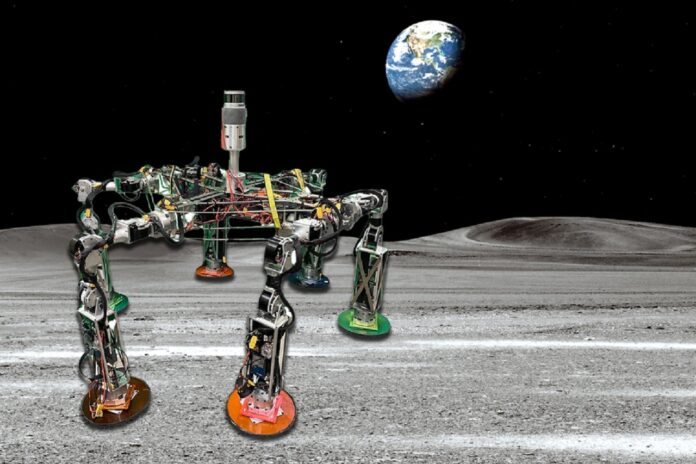In the coming years, NASA aims to send people to the Moon to start constructing a permanent base. The National Aeronautics and Space Administration (NASA)is planning a return to the Moon with the Artemis program in the second half of this decade.
Robots may perform labor-intensive operations such as constructing wires, installing solar panels, erecting communication towers, and building homes. Yet, each robot is designed to do a specific function or duty. In that case, a lunar colony may be invaded by a zoo of robots, each with unique components and operating methods.
A team of MIT engineers is designing a kit of universal robotic parts that an astronaut could easily mix and match to rapidly configure different robot “species” to fit various missions on the Moon.
The system is called WORMS, for the Walking Oligomeric Robotic Mobility System. It includes worm-inspired robotic limbs that an astronaut can easily snap onto a base. The parts can be configured to build large “pack” bots capable of carrying heavy solar panels up a hill or six-legged spider bots that can be lowered into a lava tube to drill for frozen water.
The design is flexible, sustainable, and cost-effective. The team has built and demonstrated a six-legged WORMS robot. Last week, Lordos’ team presented their results at IEEE’s Aerospace Conference and received the conference’s Best Paper Award.
The system’s main parts include the appendage, or worm, which can be attached to a body or chassis via a “universal interface block” that snaps the two pieces together through a twist-and-lock mechanism. The parts can be disconnected with a small tool that releases the block’s spring-loaded pins.
In its first generation, each appendage measures about 1 meter long and weighs about 20 pounds. In the Moon’s gravity, each limb would weigh about 3 pounds. The team has planned the specs for a more significant generation with longer and slightly heavier appendages, which could be snapped together to build “pack” bots capable of transporting heavy payloads.
Team leader George Lordos, a Ph.D. candidate and graduate instructor in MIT’s Department of Aeronautics and Astronautics (AeroAstro), said, “You could imagine a shed on the moon with shelves of worms” about the independent, articulated robots that carry their motors, sensors, computer, and battery. Astronauts could go into the shed, pick the worms they need, along with the right shoes, body, sensors, and tools, and they could snap everything together, then disassemble it to make a new one. The design is flexible, sustainable, and cost-effective.”
WORMS was conceived in 2022 as an answer to NASA’s Breakthrough, Innovative, and Game-changing (BIG) Idea Challenge, an annual competition for university students to design, develop, and demonstrate a game-changing idea.
The team aimed to design a lunar robot to navigate the extreme terrain of the Moon’s South Pole, marked by thick, fluffy dust, steep, rocky slopes, and deep lava tubes.
They took inspiration from animals such as spiders, elephants, and goats. They realized that one of the simplest animals, the worm, makes similar movements as an arm.
Lordos, who is of Greek descent, helped coin WORMS and chose the letter “O” to stand for “oligomeric,” which in Greek signifies “a few parts.”
AeroAstro undergraduate Brooke Bensche said, “Our idea was that, with just a few parts combined in different ways, you could mix and match and get all these different robots.”
Deputy team leader and AeroAstro graduate student Michael Brown said, “As we were thinking of these animal inspirations, we realized that one of the simplest animals, the worm, makes similar movements as an arm, or a leg, or a backbone, or a tail. And then the lightbulb went off: We could build all these animal-inspired robots using worm-like appendages.”
AeroAstro undergraduate Jacob Rodriguez said, “In future iterations, we hope to add more snap-on sensors and tools, such as winches, balance sensors, and drills.”
Kevin Kempton, an engineer at NASA’s Langley Research Center who served as a judge for the 2022 BIG Idea Challenge, said, “There are many buzzwords that describe effective systems for future space exploration: modular, reconfigurable, adaptable, flexible, cross-cutting, et cetera. The MIT WORMS concept incorporates all these qualities and more.”
The MIT WORMS concept is a modular, reconfigurable, adaptable, flexible, cross-cutting system for future space exploration. The team developed software that can be tailored to coordinate multiple appendages. As a proof of concept, the team built a six-legged robot about the size of a go-cart.
The result shows that WORMS is a durable, easily maintainable, low-cost, evolvable, versatile, flexible, future-proof, and modular architecture for rapidly assembling extreme-terrain and heavy-duty robots.
Journal Reference:
- George Lordos, Michael J. Brown, et al. WORMS: Field-Reconfigurable Robots for ExtremeLunar Terrain. IEEE’s Aerospace Conference.
